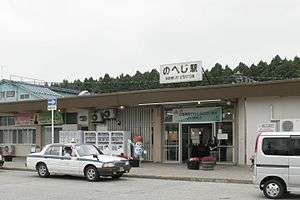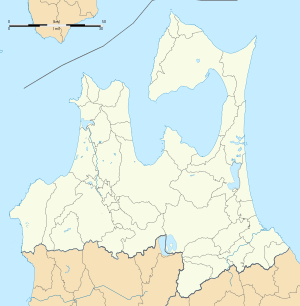Noheji Station
Noheji Station (野辺地駅, Noheji-eki) is a junction railway station in the town of Noheji, Aomori Prefecture, Japan, jointly operated by the East Japan Railway Company (JR East) and the third sector railway operator Aoimori Railway Company.
Noheji Station 野辺地駅 | |||||||||||||||||||||||||||||||||
|---|---|---|---|---|---|---|---|---|---|---|---|---|---|---|---|---|---|---|---|---|---|---|---|---|---|---|---|---|---|---|---|---|---|
 Noheji Station in July 2008 | |||||||||||||||||||||||||||||||||
| Location | 49-2 Kamikonakano, Noheji-machi, Kamikita-gun,Aomori-ken 039-3154 Japan | ||||||||||||||||||||||||||||||||
| Coordinates | 40°51′18.54″N 141°07′10.60″E | ||||||||||||||||||||||||||||||||
| Operated by |
| ||||||||||||||||||||||||||||||||
| Line(s) | |||||||||||||||||||||||||||||||||
| Distance | 44.6 km from Aomori | ||||||||||||||||||||||||||||||||
| Platforms | 1 side + 2 island platforms | ||||||||||||||||||||||||||||||||
| Connections | Bus stop | ||||||||||||||||||||||||||||||||
| Construction | |||||||||||||||||||||||||||||||||
| Structure type | At grade | ||||||||||||||||||||||||||||||||
| Other information | |||||||||||||||||||||||||||||||||
| Status | Staffed | ||||||||||||||||||||||||||||||||
| Website | Official website | ||||||||||||||||||||||||||||||||
| History | |||||||||||||||||||||||||||||||||
| Opened | 1 September 1891 | ||||||||||||||||||||||||||||||||
| Traffic | |||||||||||||||||||||||||||||||||
| Passengers (FY2018) | 294 daily | ||||||||||||||||||||||||||||||||
| Services | |||||||||||||||||||||||||||||||||
| |||||||||||||||||||||||||||||||||
| Location | |||||||||||||||||||||||||||||||||
 Noheji Station Location within Aomori Prefecture  Noheji Station Noheji Station (Japan) | |||||||||||||||||||||||||||||||||
Lines
Noheji Station is one of six principal stations served by the Aoimori Railway Line,[1] and is 44.6 kilometers (27.7 mi) from the terminus of the line at Aomori Station. It is also the terminal station for the Ōminato Line.
Station layout
Noheji Station has a single ground-level side platform and two ground-level island platforms serving five tracks, connected by a footbridge. The station building has a manned ticket office, as well as an automatic ticket machine.
Platforms
| 1 | ■ Ōminato Line | for Ōminato |
| 2 | ■ Aoimori Railway Line | for Aomori for Hachinohe |
| ■ Ōminato Line | for Ōminato | |
| 3 | ■ Aoimori Railway Line | for Misawa and Hachinohe for Aomori |
| 4/5 | ■ Aoimori Railway Line | for Hachinohe for Aomori |
 The platforms in January 2007
The platforms in January 2007
Bus terminal
Highway buses
- Enburi; For Shinjuku Station and Tokyo Station[2]
History
Noheiji Station was opened on 1 September 1891 as a station of the Nippon Railway. It was nationalized on 1 July 1906 and became a station of the Japanese Government Railways Tōhoku Main Line. On 20 March 1921, it became the southern terminus of the Ōminato Line. After the end of World War II, the JGR became the Japanese National Railways (JNR).
On 15 March 1954 an F-84 Thunderjet from nearby Misawa Air Base crashed on top of Noheji Station, destroying the station building and killing twelve people. The explosion left a crater three meters wide and two meters deep, and set fire to one of the carriages of the Tōhoku Main Line. Platforms 1 through 3 were also destroyed. The pilot ejected, but his parachute failed to open and he was also killed.[3]
From 5 August 1968, the Nanbu Jūkan Railway began operations from Noheji (operations ended in 1997). With the privatization of JNR on 1 April 1987, it came under the operational control of JR East. The control of the Tōhoku Main Line (between Hachinohe and Aomori) was transferred to Aoimori Railway on 4 December 2010, the day the Tōhoku Shinkansen was extended to Shin-Aomori.
Passenger statistics
In fiscal 2018, the station was used by an average of 294 passengers daily (boarding passengers only for the Ōminato Line).[4]
Surrounding area


- Aomori Prefectural Noheji High School
See also
- List of Railway Stations in Japan
References
- JTB Timetable December 2010 issue
- "Aoimori Railway Line Route and Fares" (pdf). September 2019. Retrieved 19 February 2020.
- "えんぶり号 - 弘南バス株式会社". www.konanbus.com. Retrieved 2016-02-07.
- http://www.asyura2.com/12/warb9/msg/630.html
- 各駅の乗車人員 (2018年度) [Station passenger figures (Fiscal 2018)] (in Japanese). Japan: East Japan Railway Company. 2019. Retrieved 21 April 2020.
External links
![]()
- Noheji Station (Aoimori Railway) (in Japanese)
- Noheji Station (JR East) (in Japanese)